
Between August 1 and the middle of September this year, anglers have the opportunity to retain larger Chinook including, at a minimum, adipose fin-clipped, hatchery-produced fish in most BC marine regions. However, make sure you are up to date on the management actions wherever you plan to fish in BC’s waters. Visit our area reports for links to management area regulations.
Adapt Your Fishing Tactics To Match Biological Changes
Terminal and Pre-Terminal Area
First, it’s important to understand two terms: What are “terminal” and “pre-terminal” areas? The terminal area is the estuary where salmon stage up, waiting for the right conditions to ascend to the spawning grounds. It can also include inlets, bays, and sounds where rivers are located at the head of long inlets. Well-known examples include Rivers Inlet, Alberni Canal, and Nootka Sound. These locations have been important in building BC’s reputation for excellent late summer Chinook angling, along with Campbell River, where tourist salmon angling in BC had its beginnings almost 150 years ago.
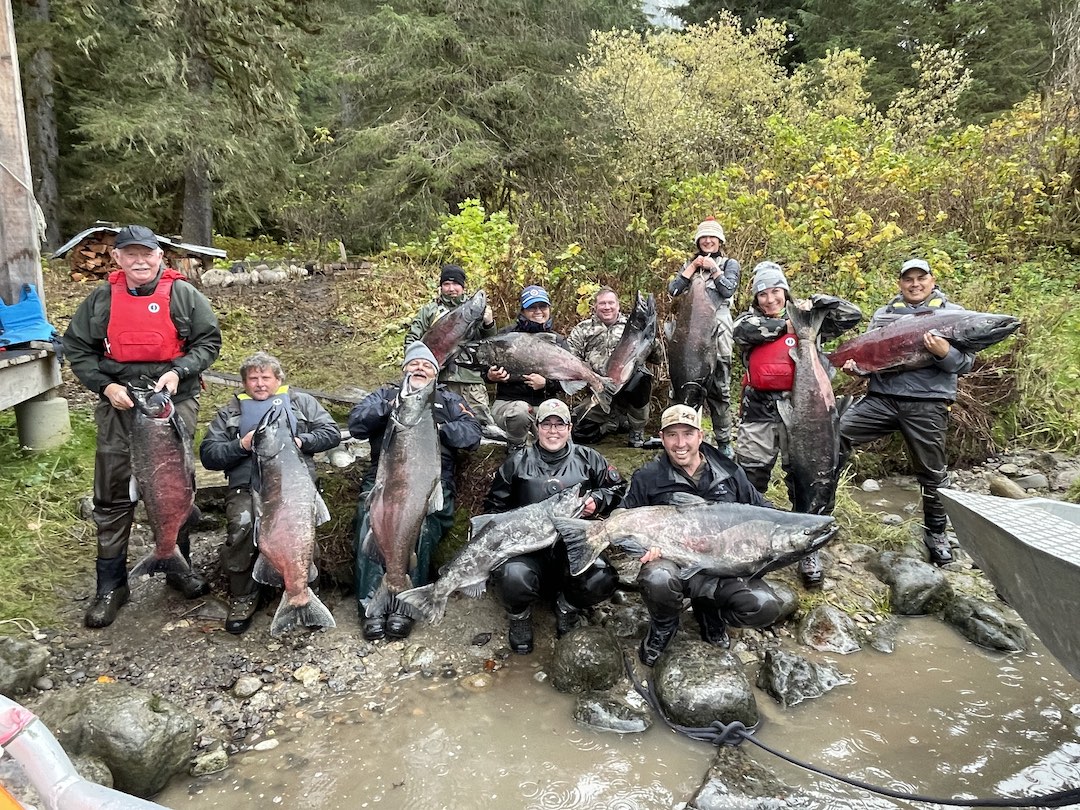
Volunteers saving the big ones Egg take at the Percy Walkus Hatchery
“Pre-terminal” areas are the last portions of the migration corridors that salmon follow before they arrive in the terminal area. These areas can be quite large. For example, when adult Chinook beach crawl along Vancouver Island’s west coast, or migrate through Johnstone, Georgia, and Juan de Fuca Straits, these areas qualify as “pre-terminal.” The deciding factors are where these fish switch from feeders to non-feeders, and when they adopt other distinctive characteristics that separate them from feeding immature Chinook.
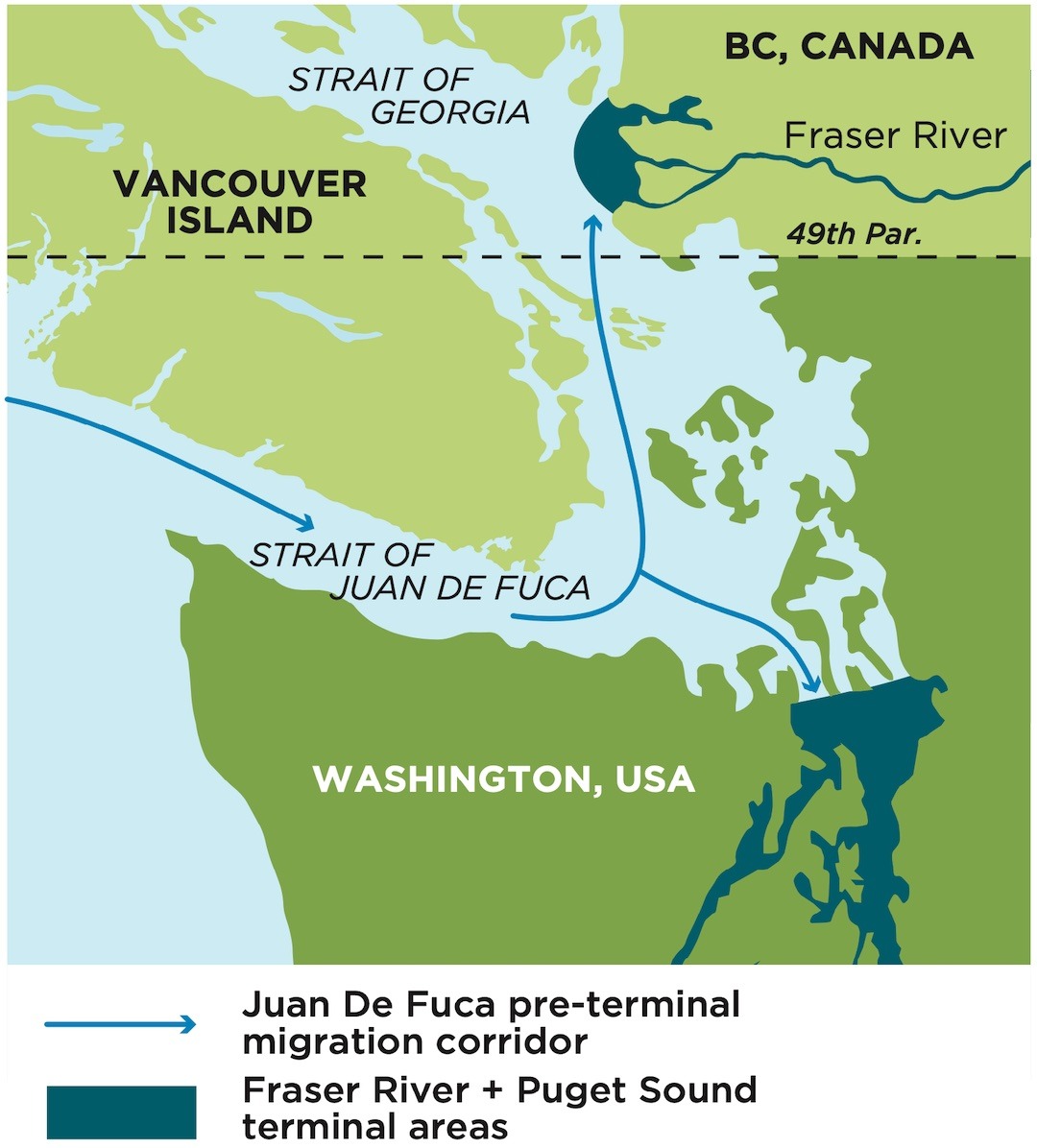
Juan de Fuca June-to-September Chinook Migration Corridor Image by Island Fisherman magazine
Adult Chinook in the Pre-Terminal and Terminal Areas Usually Have Stopped Feeding
In fact, they often stop feeding many miles away from the river mouth. Juan de Fuca Strait is a good example. With the exception of Chinook producers like the San Juan and Sooke Rivers on the Canadian side of Juan de Fuca, and improving escapements to the Elwha and Dungeness Rivers on the US side, the bulk of June-to-September Chinook passing through eastern Juan de Fuca come from Puget Sound and the Fraser River.
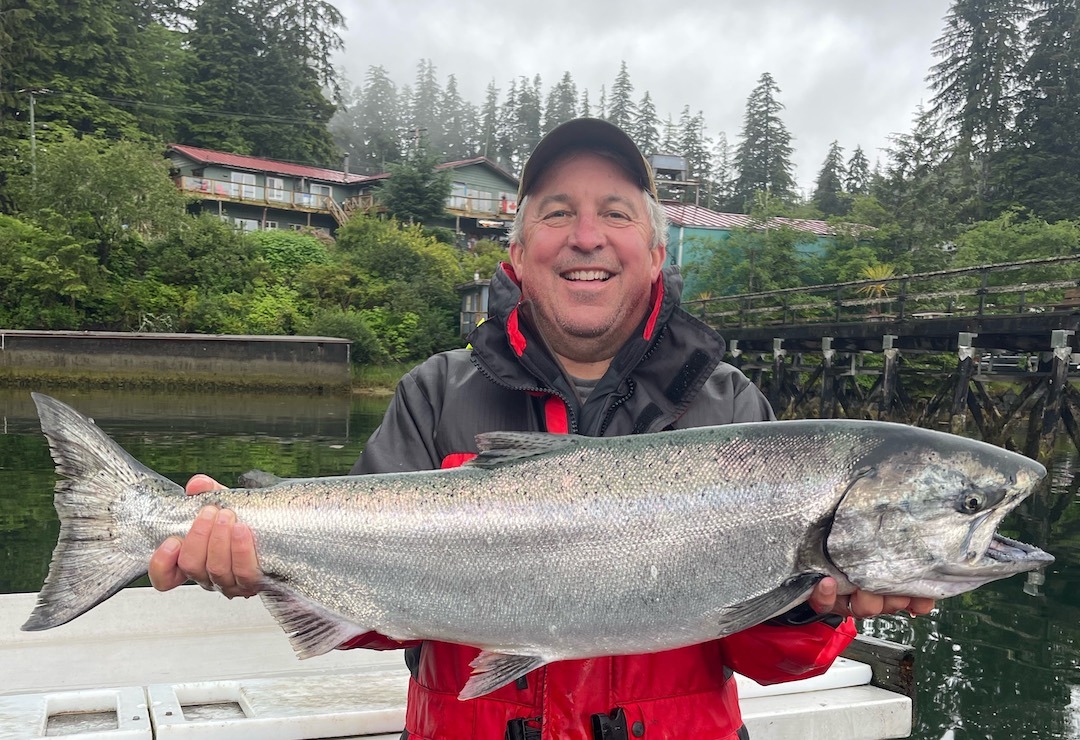
Greg Vance’s Hogust Winter Harbour Chinook Photo credit Fred Harris
Adult Chinook Bite Patterns are Different
Instead of bites occurring around a tide change, which is the best time to fish for feeding Chinook, the strongest terminal Chinook bites almost always take place from just before daybreak until mid-morning, and then a few hours before dark. This is when the “early bird gets the worm” strategy really pays off.
The Bite Pattern for Adult Chinook in Migration Corridors is Different
Their bite pattern doesn’t match the bite patterns for either feeding or terminal area Chinook. Once again, a Chinook’s biologically inherent factors play a role along with the tidal current patterns.
This is hardwired into their DNA. Chinook have very predictable migration patterns. From year to year, they show up in the same places along the same migration routes at almost exactly the same time. Variations in this pattern, usually caused by changing ocean
Migrating Chinook also take advantage of tidal currents to conserve energy. They rest in quiet back eddies on the outbound tide, then use the flood tide’s escalator effect to get to the river mouth efficiently. The bite is almost always much stronger on the flood tide than the ebb and often occurs in locations where the flood current pushes salmon closer to shore. So change your tactic from fishing before, through, and a while after slack water to starting just before low slack, and fishing much longer into the flood tide.
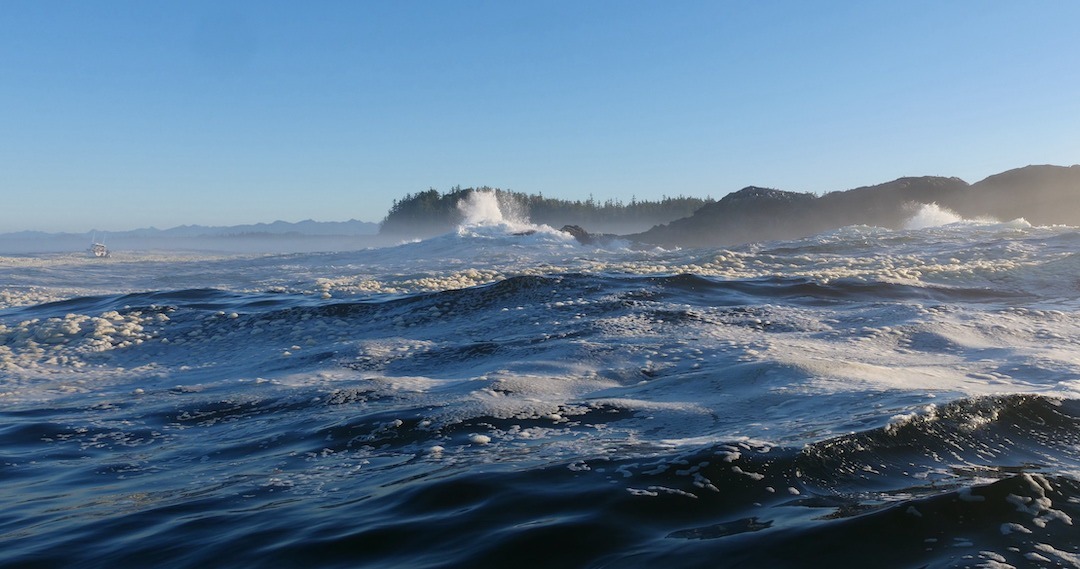
Fishing Close to the Rocks on a Flood Tide at Dawn Photo Island Fisherman
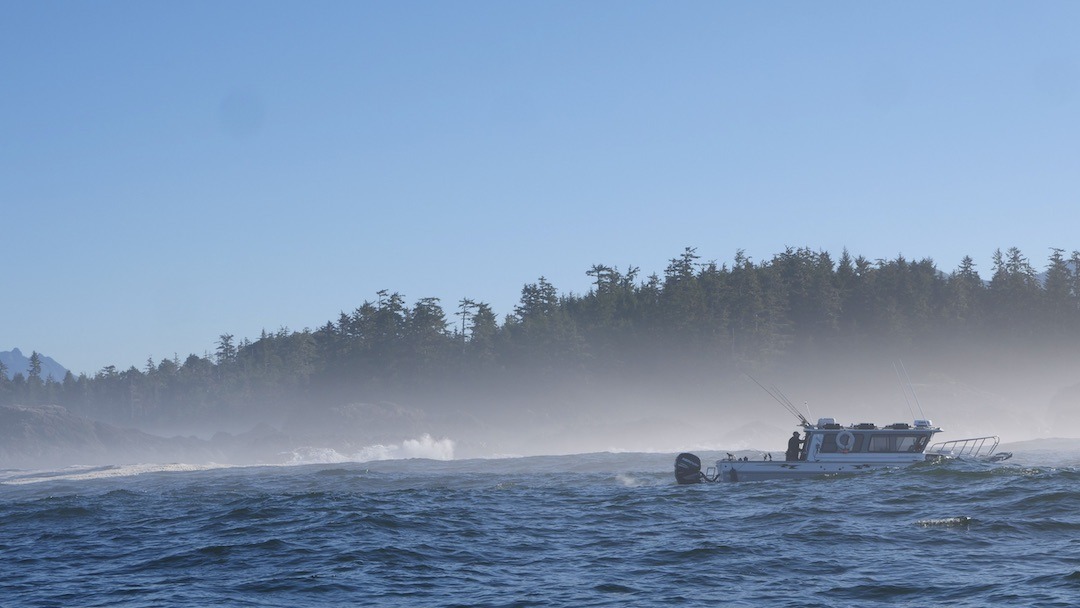
Fishing Close to the Rocks on a Flood Tide at Dawn Photo Island Fisherman 2
Fish Shallower for Late Summer Adult Chinook
Anglers generally fish deep for feeding Chinook, which often means as close to bottom as possible. Not so for migrating Chinook. The nearer these adults get to the river mouth, the shallower they run. For example, a mature feeder Chinook usually will forage within 20′ of the bottom during winter and spring. By August, it’s likely off the feed and well into migration mode, where it’s probably cruising along the middle to upper part of the water column somewhere in the 30′ to 90′ range.
By the time that Chinook arrives in the pre-terminal and terminal areas, like Barkley Sound and Alberni Inlet, it might be swimming at 15′ to 20′, especially in the early morning. So, anglers should have at least one lure positioned near the surface at daybreak. As morning progresses, incrementally move your lures slightly deeper.
Terminal Chinook Like Bigger Lures
Bigger spoons, plugs, and baits produce better catches. Conventional wisdom says this is due to their increasingly aggressive tendencies brought on by impeding competition for spawning dominance, the best gravel for spawning, and to drive away sea-run and native trout that are after loose salmon eggs. So, their strike response has shifted from a feeding trigger to an attack trigger.
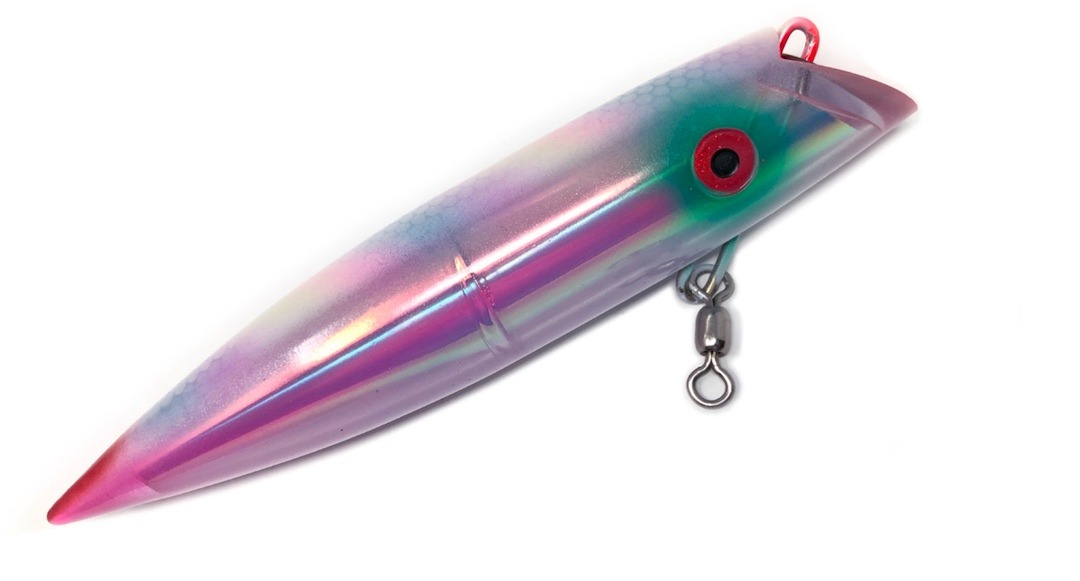
Tomic Lures RVP2 Series #12119 “Game Changer” 6″ or 7″
Fish Close To Shore Along the Approaches to the Terminal Area
We accidentally stumbled on this bit of fishing knowledge 40 years ago, while trolling along a popular fishing tack in Nootka Sound called The Wall. The tack, still popular today, starts at the entrance to Galiano Bay and finishes at Five Fingers Bay near Camel Rock. It got its name because it looks like a flat, nearperpendicular wall with deep water along its entire length. It contains only one significant indentation just before Five Fingers Bay.
As the ebb tide picked up velocity, the bite dropped off. Each time we passed the indentation we noticed schools of baitfish dimpling the surface. That was the aha moment. If the feed is there to get out of the current flow, maybe the Chinook are there, too. On the next pass, we tucked into the indentation as tight to shore as possible, and 15 minutes later we had a 46-pounder. This tactic paid off many times in the following years when fishing for pre-terminal migratory Chinook, even producing one of the top prize winners for our team in the Port Alberni Salmon Derby.
When the tide swings to the flood, move a bit further offshore into the flood tide highway—this is where you’ll find Chinook.
Trolling Speed, Lure Action, and Leader Length
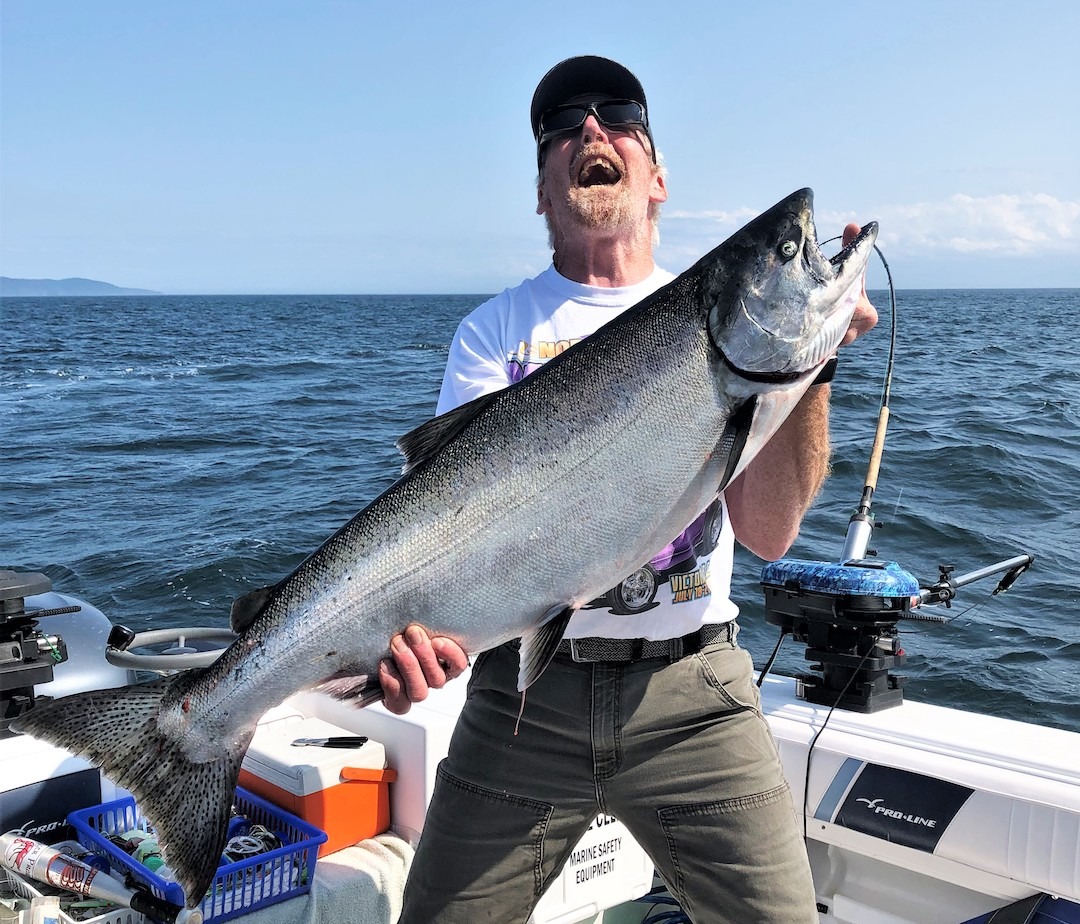
Angler Glen Varney’s Otter Point Sooke 25-pounder Photo courtesy Glen Varney
There is an argument for trolling a bit slower for terminal Chinook, but slow trolling is less effective with plugs. So normal to slightly slower than normal trolling speed is a safe strategy, as long as it doesn’t decrease the effectiveness of the lures being used.
However, running less active lures does increase the mature Chinook strike rate as you near the terminal area. For example, fishing with wider-action, slow-rolling natural baits is a better option than trolling with the tighter, fast-rolling baits you’d use for actively feeding Chinook.
Fishing with the correct leader length in combination with a big attractor is extremely important. The simple rule of thumb is to increase the leader length as the fishing season progresses from winter to late summer, particularly for Chinook salmon. For example, if your winter/early spring leader lengths for spoons and baits range from 2.5′ to 4.5′ extend those to around 5′ for larger spoons, and 6′ to 7′ for bigger natural baits. This lengthening process tones down jerky, erratic lure actions, making them more appealing to late-summer adult Chinook salmon.
As a general rule, you will have far more success if you understand how the physiological changes that take place within all pre-spawning salmon species influence fishing tactics and lure presentations.

Robert Parent and Samuel Hicks King Slayer Charters Esperanza Inlet
This article appeared in Island Fisherman magazine. Never miss another issue—subscribe today!
Visit the Store
$34.99
$34.99
Featured Catch

Joel Unickow halibut (Photo: Rob Frawley Lucky Strike Sportfishing Tofino)








